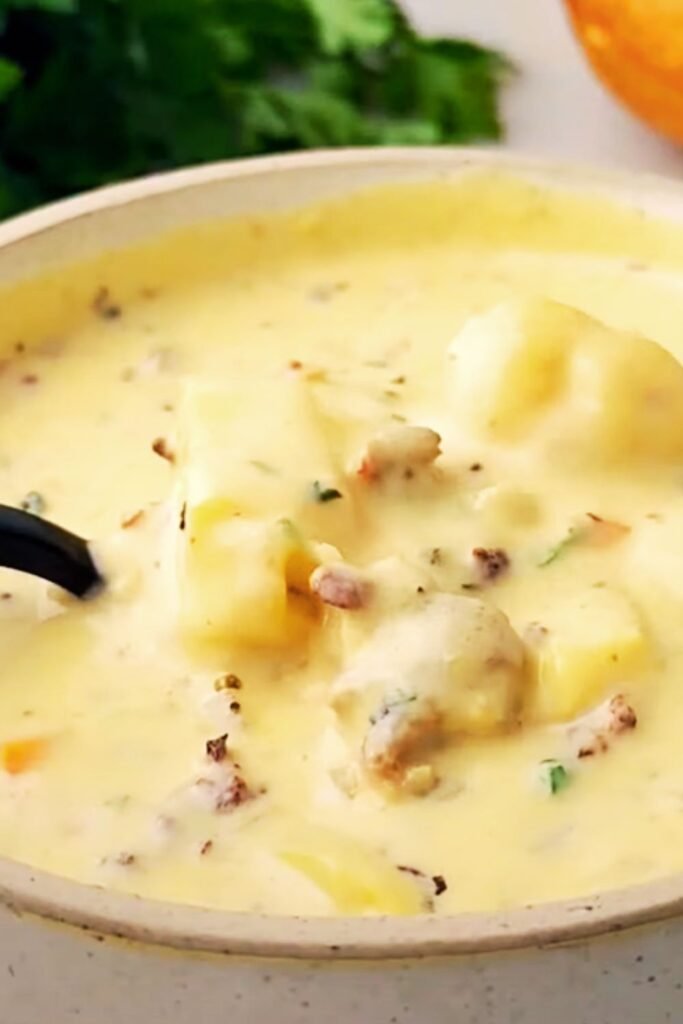When the cold winds start howling and frost begins painting my windows, I find myself craving something that wraps around me like a warm hug. That’s exactly what this potato and sausage chowder delivers – a bowl of pure comfort that transforms simple ingredients into something absolutely magical.
I’ve been perfecting this recipe for years, tweaking it through countless winter evenings until I achieved what I consider the perfect balance of creamy richness and hearty satisfaction. This isn’t just soup; it’s a meal that fills your kitchen with incredible aromas and your belly with warmth that lasts for hours.
What Makes This Chowder Special
Chowder: A thick, creamy soup traditionally made with seafood, vegetables, and a dairy base, originating from coastal New England communities.
Hearty Winter Soup: A substantial, warming dish designed to provide comfort and nourishment during cold weather months.
One-Pot Meal: A complete dish cooked entirely in a single vessel, minimizing cleanup while maximizing flavor development.
My version stands apart because I use a combination of cooking techniques that build layers of flavor. Instead of simply throwing everything into a pot, I brown the sausage first to create those beautiful caramelized bits, then use that same pan to develop the vegetable base. This foundation creates depth that you simply can’t achieve with shortcuts.
The secret lies in my potato selection too. I use a combination of waxy and starchy potatoes – the waxy ones hold their shape and provide texture, while the starchy ones break down slightly to naturally thicken the chowder without requiring excessive flour or cream.
Essential Ingredients Breakdown
| Ingredient | Quantity | Purpose | Substitution Options |
|---|---|---|---|
| Italian Sausage (removed from casings) | 1 lb | Primary protein, flavor base | Turkey sausage, chicken sausage, chorizo |
| Yukon Gold Potatoes | 2 lbs, diced | Main vegetable, natural thickener | Red potatoes, fingerlings |
| Russet Potatoes | 1 lb, diced | Texture, additional thickening | More Yukon Gold |
| Yellow Onion | 1 large, diced | Aromatic base | White onion, shallots |
| Celery | 3 stalks, diced | Crunch, classic chowder flavor | Fennel bulb |
| Carrots | 2 medium, diced | Sweetness, color | Parsnips |
| Garlic | 4 cloves, minced | Aromatic enhancement | Garlic powder (1 tsp) |
| All-Purpose Flour | 3 tablespoons | Thickening agent | Cornstarch (2 tbsp) |
| Chicken Broth | 4 cups | Liquid base | Vegetable broth, seafood stock |
| Heavy Cream | 1 cup | Richness, creaminess | Half-and-half, evaporated milk |
| Whole Milk | 1 cup | Base creaminess | 2% milk, additional cream |
| Bay Leaves | 2 | Aromatic depth | Dried thyme |
| Fresh Thyme | 1 tablespoon | Herbal notes | Dried thyme (1 tsp) |
| Smoked Paprika | 1 teaspoon | Smoky depth | Regular paprika |
| Salt | To taste | Flavor enhancement | Sea salt, kosher salt |
| Black Pepper | To taste | Spice balance | White pepper |
| Green Onions | 3, chopped | Fresh garnish | Chives, parsley |
Step-by-Step Cooking Process
Preparation Phase
Before I even turn on the stove, I make sure everything is prepped and ready. This chowder comes together relatively quickly once you start cooking, so having all your ingredients prepared saves time and prevents any burnt garlic disasters.
I dice my potatoes into uniform pieces – about ¾-inch cubes work perfectly. They’re large enough to provide substantial bites but small enough to cook evenly. I keep the Yukon Gold and Russet potatoes separate initially, as I add them at slightly different times.

Building the Flavor Base
I start by heating a large, heavy-bottomed pot or Dutch oven over medium-high heat. The weight of the pot matters here – it distributes heat evenly and prevents hot spots that could burn the sausage.
Once the pot is hot, I add the sausage meat, breaking it up with a wooden spoon as it cooks. This step is crucial for developing flavor. I let the sausage brown properly, resisting the urge to stir it constantly. Those golden-brown bits that form on the bottom of the pot are pure flavor gold.
After about 6-8 minutes, when the sausage is beautifully browned and cooked through, I remove it with a slotted spoon, leaving behind all those gorgeous drippings. This rendered fat becomes the base for sautéing my vegetables.
Vegetable Foundation
Into that same pot goes my diced onion, celery, and carrots. The vegetables sizzle immediately in the hot fat, and I can hear them releasing their moisture and concentrating their flavors. I cook them for about 5 minutes, stirring occasionally, until the onion becomes translucent and the celery softens.
The garlic goes in next, and I cook it for just 30 seconds until fragrant. Garlic burns quickly, so I keep it moving and watch it carefully.
Creating the Roux
Now comes the technique that separates good chowder from great chowder – making a proper roux. I sprinkle the flour over the vegetables and stir constantly for about 2 minutes. This cooks out the raw flour taste and creates a base that will thicken the chowder beautifully.
The mixture might look a bit dry at this point, but that’s exactly what I want. The flour needs to coat all the vegetables and absorb those flavorful fats.
Building the Liquid Base
Slowly, I pour in the chicken broth while stirring constantly. This prevents lumps from forming and ensures a smooth base. I add the broth gradually, about a cup at a time, stirring well after each addition.
Once all the broth is incorporated, I add the bay leaves, thyme, and smoked paprika. The paprika gives the chowder a beautiful color and adds a subtle smoky note that complements the sausage perfectly.
Potato Cookery
I add the Russet potatoes first since they take longer to cook and will break down more, contributing to the chowder’s thickness. After bringing the mixture to a boil, I reduce the heat to maintain a gentle simmer and cook for about 10 minutes.
Then I add the Yukon Gold potatoes and the browned sausage back to the pot. These potatoes hold their shape better and provide the perfect texture contrast. I continue simmering for another 15-20 minutes until all potatoes are tender when pierced with a fork.

Final Enrichment
The final step is where the magic really happens. I remove the pot from heat and slowly stir in the heavy cream and milk. I do this off the heat to prevent the dairy from curdling, which can happen if it’s added to boiling liquid.
I taste and adjust the seasoning at this point, adding salt and pepper as needed. Remember that the sausage and broth already contribute salt, so I taste before adding more.
Nutritional Information and Health Benefits
| Nutrient | Per Serving (1.5 cups) | Daily Value % |
|---|---|---|
| Calories | 385 | 19% |
| Total Fat | 22g | 28% |
| Saturated Fat | 10g | 50% |
| Cholesterol | 65mg | 22% |
| Sodium | 1,240mg | 54% |
| Total Carbohydrates | 32g | 12% |
| Dietary Fiber | 4g | 14% |
| Sugars | 8g | – |
| Protein | 18g | 36% |
| Vitamin C | 45mg | 50% |
| Potassium | 1,100mg | 23% |
| Iron | 3mg | 17% |
Based on 6 servings per recipe
Despite being a comfort food, this chowder provides substantial nutritional benefits. The potatoes offer excellent potassium content, supporting heart health and proper muscle function. The vegetables contribute fiber and vitamins, while the sausage provides high-quality protein.
The combination of complex carbohydrates from potatoes and protein from sausage creates sustained energy release, making this an ideal meal for cold, active days.
Serving Suggestions and Accompaniments
| Accompaniment Type | Options | Why It Works |
|---|---|---|
| Bread | Crusty sourdough, cornbread, biscuits | Absorbs broth, adds texture contrast |
| Salads | Simple green salad, coleslaw, cucumber salad | Cuts richness, adds freshness |
| Pickled Items | Dill pickles, pickled onions, sauerkraut | Acid balance, palate cleanser |
| Crackers | Oyster crackers, saltines, cheese crackers | Traditional chowder pairing |
| Vegetables | Steamed broccoli, roasted Brussels sprouts | Additional nutrition, color |
I love serving this chowder with thick slices of sourdough bread for dipping. The tangy bread cuts through the richness beautifully. For a complete meal, I often prepare a simple mixed green salad with a light vinaigrette to balance the hearty soup.
During particularly cold evenings, I sometimes top each bowl with a sprinkle of sharp cheddar cheese and crispy bacon bits, though the chowder is perfectly complete on its own.
Storage and Reheating Guidelines
Refrigerator Storage
- Store cooled chowder in airtight containers
- Maximum storage time: 3-4 days
- Allow chowder to cool completely before refrigerating
- Separate into smaller containers for faster cooling
Freezer Storage
- Freeze for up to 2 months (note: texture may change slightly)
- Leave space in containers for expansion
- Label with date and contents
- Thaw overnight in refrigerator before reheating
Reheating Methods
| Method | Time | Temperature | Best For |
|---|---|---|---|
| Stovetop | 8-10 minutes | Medium-low heat | Best texture retention |
| Microwave | 2-3 minutes | 50% power | Single servings |
| Slow Cooker | 1-2 hours | Low setting | Large quantities |
| Oven | 20-25 minutes | 300°F (covered) | Family portions |
When reheating, I always use gentle heat and stir frequently to prevent the dairy from separating. If the chowder seems too thick after storage, I thin it with a little milk or broth until it reaches the desired consistency.
Variations and Customizations
Protein Variations
I’ve experimented with numerous protein substitutions over the years. Turkey sausage creates a lighter version while maintaining flavor, and chicken sausage works beautifully for those avoiding pork. For a seafood twist, I sometimes substitute the sausage with chunks of white fish or even lobster meat added in the final minutes of cooking.
Vegetable Adaptations
Corn kernels make an excellent addition, providing sweetness and color. I sometimes add a cup of frozen corn during the last 5 minutes of cooking. Diced bell peppers, added with the other vegetables, contribute additional flavor and nutrition.
For those following specific dietary requirements, I’ve successfully made dairy-free versions using coconut milk and vegetable broth, though the flavor profile changes significantly.
Spice Level Adjustments
The base recipe is fairly mild, making it family-friendly. However, I often customize the heat level based on my audience. Hot Italian sausage instead of mild provides a nice kick, and a pinch of red pepper flakes during the vegetable sautéing phase adds warmth without overwhelming heat.

Troubleshooting Common Issues
Preventing Curdled Dairy
The most common issue I encounter is curdled cream or milk. This happens when dairy is added to liquid that’s too hot or when the mixture boils after dairy addition. Always remove the pot from heat before adding cream, and never let the chowder boil once dairy is incorporated.
Achieving Perfect Thickness
If my chowder turns out too thin, I have several remedies. I can simmer it uncovered to reduce liquid, mash some of the potatoes against the pot sides to release more starch, or mix a tablespoon of cornstarch with cold milk and stir it in.
Conversely, if it’s too thick, I thin it gradually with warm milk or broth until reaching the desired consistency.
Flavor Balancing
Sometimes the chowder needs a flavor boost. A splash of white wine vinegar or lemon juice can brighten the entire pot. If it tastes flat, I check the salt level first, then consider adding more herbs or a dash of hot sauce.
Seasonal Adaptations
Spring Version
During spring, I sometimes add fresh peas and asparagus pieces in the final minutes of cooking. The bright green vegetables add color and freshness to the hearty base.
Summer Modification
While chowder isn’t typically summer fare, I’ve created a lighter version using chicken broth instead of cream-based liquid and adding fresh corn and zucchini.
Fall Enhancement
Autumn calls for additions like diced butternut squash or sweet potatoes, which complement the regular potatoes beautifully and add subtle sweetness.
Winter Intensification
During the coldest months, I sometimes add extra root vegetables like parsnips or turnips, creating an even heartier version that’s perfect for harsh weather.
Questions and Answers
Q: Can I make this chowder in a slow cooker? Absolutely! Brown the sausage and sauté the vegetables in a skillet first, then transfer everything to your slow cooker with the broth and potatoes. Cook on low for 6-8 hours or high for 3-4 hours. Add the dairy during the last 30 minutes to prevent curdling.
Q: What’s the best way to prevent lumpy chowder? The key is making a proper roux with the flour and vegetables, then adding liquid gradually while stirring constantly. If lumps do form, use an immersion blender briefly or strain the chowder through a fine-mesh sieve.
Q: Can I use different types of sausage? Definitely! I’ve used chicken sausage, turkey sausage, chorizo, and even plant-based sausages successfully. Each brings its own flavor profile to the dish. Just ensure whatever you choose is fully cooked before adding back to the chowder.
Q: How do I know when the potatoes are perfectly cooked? The potatoes should be tender when pierced with a fork but not falling apart completely. This usually takes 20-25 minutes of simmering. The Russet potatoes will break down more than the Yukon Gold, which is exactly what you want for texture.
Q: Can I make this chowder dairy-free? Yes, though the texture and flavor will be different. Use coconut milk or cashew cream instead of dairy cream, and substitute the milk with additional broth or plant-based milk. The result is lighter but still delicious.
Q: What should I do if my chowder is too salty? Add diced raw potatoes and simmer until tender – they’ll absorb excess salt. Alternatively, add a small amount of sugar or a splash of vinegar to balance the saltiness. Diluting with unsalted broth or milk also helps.
Q: How can I make this recipe healthier? Use turkey sausage instead of pork, substitute half-and-half for heavy cream, add more vegetables like carrots and celery, and use low-sodium broth. You can also increase the vegetable-to-meat ratio for more nutrients.
Q: Why does my chowder separate when reheating? This happens when dairy-based soups are heated too quickly or at too high a temperature. Always reheat gently over low heat, stirring frequently. If separation occurs, whisking vigorously often brings it back together.
Q: Can I prepare components ahead of time? Absolutely! You can brown the sausage and chop all vegetables up to two days in advance. Store them separately in the refrigerator. You can even make the entire chowder through adding the potatoes, then finish with dairy when ready to serve.
Q: What wine pairs well with this chowder? A crisp white wine like Sauvignon Blanc or Pinot Grigio complements the richness beautifully. The acidity cuts through the cream while not competing with the hearty flavors. For those preferring red wine, a light Pinot Noir works well.
This potato and sausage chowder has become my go-to recipe for cold weather comfort. It’s substantial enough to serve as a complete meal, yet refined enough for entertaining guests. The combination of textures, from the tender potatoes to the savory sausage, creates a symphony of satisfaction in every spoonful.
What I love most about this recipe is its forgiving nature. You can adjust ingredients based on what’s available in your pantry, customize the spice level for your family’s preferences, and even prepare it mostly in advance for busy weeknights. It’s the kind of recipe that improves with practice, and each time I make it, I discover new nuances in flavor and technique.
Whether you’re feeding a hungry family after a day of winter activities or hosting friends for a cozy dinner party, this chowder delivers warmth, comfort, and satisfaction that transforms any meal into a memorable experience.